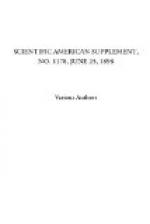It has long been known that feathers and hair are electrical bodies, but until recently we have had little information about their electrical properties or the conditions in which these properties are manifested. Most of these phenomena were first observed by Exner, and in the work of Dr. Schwarze are found collected a mass of facts that cannot fail to interest the physician and the biologist; besides, we find there a description of Exner’s apparatus which was used by Schwarze in most of his experiments on electrical phenomena of this kind. By the side of gold leaf electroscopes we see a feather electroscope, which is fastened to its support by means of a silken thread. A feather waved through the air is positively electrified, while the air itself seems to be charged with negative electricity.... Two feathers rubbed together in the natural position are so electrified that their lower surface is negative and the upper positive.... These experiments and others still have been utilized to study the vital relations of animals and the biological signification of these phenomena. Most feathers stick together and remain so even after being dried; if they then are waved through the air, the barbs of the feather separate, owing to differences of electrification. No bird needs to attend to its plumage at the end of a long flight, for while the large feathers are positively electrified by friction against the air, the white down has become negative, and so there is attraction between it and the feathers. Another consequence of this production of electricity during flight is that during winds, even the most violent, the plumage does not become ruffled, but rests tightly against the bird’s body, for in this case the wing feathers, which overlap, rub against each other and become electrified in contrary senses. If the bird flies toward the ground, flapping its wings, it compresses the air below them, and, supposing that the wing feathers can bend aside, the experiments of Exner show that by the friction the upper side of one feather and the lower side of that which is just above are electrified oppositely, the more powerfully as the rubbing is greater, which always causes them to resume the normal position.—L’Electricien.
* * * * *
SELECTED FORMULAE.
Removal of ink from hectograph.—It is recommended in Suedd. Ap. Ztg. to pour crude hydrochloric acid upon the hectograph, rub with a wad of cotton, then wash off by holding under cold running water and drying with a cloth. The hectograph may be used again immediately.




